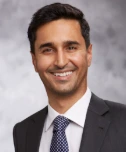
Clinical Specialty Advisor: Jamal Mahar, MD, M.Ed.
Advanced Heart Failure and Transplant Cardiologist - Banner
Note: You must be a current student with an active account to access Dr. Mahar's Profile

Clinical Specialty Advisor: Jaron Smith, MD
Pediatrics at Phoenix Children's Hospital
Note: You must be a current student with an active account to access Dr. Smith's Profile
Frequently Asked Questions by MS1s and MS2s
Med-Peds is a unique opportunity to train in a combined program, allowing graduates to become board certified in both specialties. First year students should consider involvement in both the Medicine and Pediatric Interest Groups. Consider shadowing a Med-Peds Physician to learn more about how they structure their clinical practice.
Research is not required, but it may help show interest and may make a student more competitive for highly ranked programs. If a student is interested in pursuing research it would be optimal to have one or two projects where the student played a major role rather than several projects with minimal involvement.
Due to the combined dual nature of a Med-Peds program there is a wide breadth of topics open for research exploration. To narrow it down, start by thinking about what questions and topics are interesting to you. Your Career and Professional Advisor can help provide you with local Pediatrics or Internal Medicine Specialty Advisor contacts who may need help with ongoing projects. These Mentors, as well as Dr. McEchron, can provide great resources. Work with your peers, recent graduates, local Residents and Fellows as well as Pediatric faculty and express your interest in getting involved.
Volunteer work is not required. If a student feels they can adequately balance academics while participating in community service or extracurricular activities it may help to develop a well rounded application and positively contribute to the community. The Community Health Initiative and the Wesley Health Center are both excellent opportunities to become involved in the medical care of the Phoenix community.
Learn more about the Community Health Initiative here
Learn more about the Wesley Health Clinic here
The National Resident Matching Program tracks statistical scores for students matching into each specialty. Learn more about the Med-Peds match trends here
Frequently asked Questions by MS3s and MS4s
It is fine to ask for a letter of recommendation (LOR) during your Pediatric or Internal Medicine Clerkship during third year. We recommend also doing a Pediatric or Internal Medicine sub-Internship and possibly an away rotation in Blocks 1-5 of your 4th year to facilitate developing professional relationships and obtaining letters of recommendation.
You should have your CV updated and your personal statement available for reference. If you are asking for a LOR during a clinical rotation, consider asking for it about three weeks into the rotation from a faculty member with whom you have worked closely, ideally when the impression of your performance is fresh in the letter writer’s mind. When asking for a Letter of Recommendation it is best to do it in person. It is appropriate to ask specifically if they would be comfortable writing a “strong letter of recommendation.” Letters should be uploaded to ERAS directly by the letter writers by the beginning of September of your fourth year, so make sure to give your letter writers ample time to write their letters, and be sure to thank them for their effort.
You will need a minimum of three, and at least one from someone in Internal Medicine and one from someone in Pediatrics.
Yes.
Most programs are now requiring a letter from both Internal Medicine and Pediatrics Chairs. Check with individual programs for specific requirements.
An away rotation is not required. Some of the benefits of doing an away rotation include networking in an area of the country where you would like to end up, as well as figuring out if a particular residency program is a good fit. We recommend working closely with your Career Advisor and Specialty Advisor to help with this decision.
Information specific to Med-Peds:
Mentorship relationships with Med-Peds trained physicians can help students fully understand the varied career path options available within this field. These specially trained physicians are uniquely suited to take care of patients with child onset illness that survive into adulthood (for example, cystic fibrosis). In addition to becoming board certified in both Internal Medicine and Pediatrics, graduates have the opportunity to apply for fellowships in either medicine or pediatrics, or a dually accredited program.
Med-Peds Programs rely heavily on the support of the individual Internal Medicine and Pediatric Departments to provide excellent training resources. The majority of the teaching is going to come from the Internal Medicine and Pediatrics categorical faculty. When evaluating a Med-Peds Program it is important to look at each individual component program when deciding where to apply.
Resident Continuity Clinic can either be combined, where residents see both adult and pediatric patients within the same clinic, or separate, where residents see adults and children separately depending on the day or week. There are advantages and disadvantages to both structures. Take the time to speak with current Residents and Faculty at programs to discuss how clinic time is structured.
Med-Peds Program Directors can be either Medicine or Pediatrics, or a combined Med-Peds trained physician. Regardless of the Program Director, all programs follow the same ACGME standards.
What is the difference between Med-Peds and Family Medicine?
Med-Peds is a four year curriculum that focuses on two different specialty areas. This is in contrast to Family Medicine which is a three year curriculum with a slightly broader scope also encompassing Obstetrical and Surgical training. As compared to Family Medicine, Med-Peds tends to have more in-patient than out-patient rotations, and larger emphasis in critical care.
Update for Academic Year 24-25
- Note: You must be a current student with an active account to access
Elective Recommendations from Clinical Specialty Advising
Additional Resources:
Med-Peds Specialty Report May 2023
Learn about the National Med-Peds Residents’ Association here
Review the Med-Peds Fellowship Guide here
Learn about the University of Arizona Med-Peds Residency Program here

